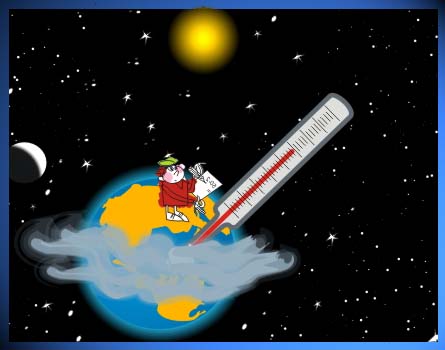
Stop the global warming! |
STOP THE GLOBAL WARMING!
Project description:
Climate change is a reality. Today, our world is hotter than it has been in two thousand years. Given the current trends, the global temperature will likely climb higher than at any time in the past two million years. This follows increasing droughts, floods and extreme weather...
The global warming comes from the "greenhouse" gases (carbon dioxide gas, Methane, Nitrous oxide, Sulfur aerosols). While the surface of the earth is heated by the sun, about 70% of the sun's energy is radiated back into space. But some of the infrared radiation is trapped by greenhouse gases, which warm the atmosphere, and reflect heat back down to Earth.
To stop the global warming we need to reduce the emission of greenhouse gases. But where come these gases from? And what could we do with our hands to reduce the emission of carbon dioxide gas and to stop the global warming? We will try to find the answers through collabrotive work with help of Internet.
Required materials:
Computer with Internet
Project timeline:
October - November
Starting the project. Invitation to partners. Team introduction.
November - April
Measuring of carbone dioxide emission in a region and looking for the ways to reduce it.
April - Mai
Making reports about our progress. Editing simple summary, creating presentations,
Target age group:
Students of the secondary school age are invited.
Project language:
The project will take place in English but students are welcome to join the project and post their contributions in their home language.
Translations would be helpful if possible.
Project resources:
Start to study what is climate change and global warming here:
http://news.bbc.co.uk/hi/english/static/in_depth/sci_tech/2000/climate_change/default.stm
Measure your ecological footprint here: http://www.earthday.net/footprint/index.asp
Project activities:
- Look for and collect news about global warming in the radio, television and newspapers or magazines (the whole year)
- Measure our ecological footprint: (October - November). Use the link http://www.earthday.net/footprint/index.asp
- Look at the way of mobility of the people - family and school: if they move on foot, by bike, by bus, by car - alone or in group; apply a questionnaire about it. (October / November)
- Look around and search some renewable energy (solar, wind, hydroelectric, bio energy, wave power, river power, etc.) and make an interview to the people that use some of that energy ? if we find some. - (October / November / the whole year)
- Apply a questionnaire about the possible "greenhouse effect"-promoting products and materials people use at home, recycling and waste reduction. (November)
- Read our consumption of energy (November / December), look for ideas to reduce it (January / February) and measure again applying our ideas. (March /April)
- Apply one idea (from last school year) to reduce the waste of water. (the whole year)
- Grow plants to help the emission of oxygen to the atmosphere. (the whole year)
Publishing Students' Work in KidSpace
Teachers, together with their students, will insert drawings and text in their own Kidspace page after they receive a login and password.
Using images in KidSpace:
- Obey copyright laws and only use images that you have expressed permission to use on the web. This means that images taken from websites without the owner's permission may not be put on Kidlink webpages. Teachers placing student images on the web should have permission from parents to do this.
Below are two copyright resources:
"Technology and Learning"
http://i.cmpnet.com/techlearning/pdf/db_area/archives/TL/2002/10/copyright_chart.pdf
A Teacher's Guide to Fair Use and Copyright
http://home.earthlink.net/~cnew/research.htm - Kidlink discourages use of clipart in our projects. Please use original drawings by students. All student art should be identified with the name, age, gender and country of the student artist.
- Specific directions for uploading image files to KidSpace can be found in the "Help" link on the top bar on any KidSpace page. Images should be no wider than 350 pixels and must be in .jpg or .gif format.
- Kidlink's policy on artworks sent to Kidlink is here: http://www.kidlink.org/english/general/web/art.html
Project evaluation:
Apply a questionnaire to check for our reduction of gas emissions.
Project moderator:
Andrew Gavrilov: gavrilov_an@list.ru or gavrilov_an@yahoo.com
Add Comment Deactivated .
